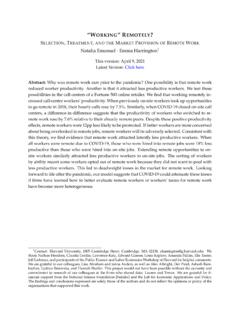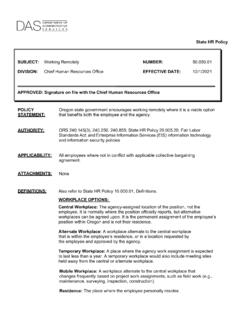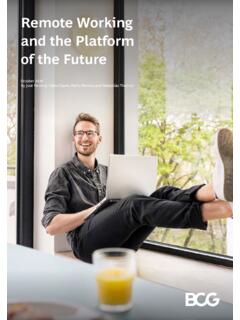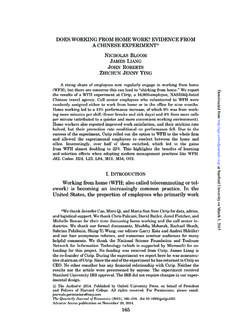Transcription of “WORKING” REMOTELY - Harvard University
1 W ORKING R EMOTELY ? S ELECTION , T REATMENT, AND THE M ARKET P ROVISION OF R EMOTE W ORK. Natalia Emanuel Emma Harrington1.. (Job Market Paper). This version: November 12, 2020. Latest Version: Click here Abstract Why was remote work so rare prior to Covid-19's lockdown? One possibility is that work- ing REMOTELY reduces productivity. Another is that remote work attracts unobservably less productive workers. In our setting of call-center workers at a Fortune 500 retailer, two natural experiments reveal positive productivity effects of remote work. When Covid-19. closed down the retailer's on-site call-centers, a difference-in-difference design suggests the transition from on-site to remote work increased the productivity of formerly on-site workers by 8% to 10% relative to their already remote peers.
2 Similarly, when previously on-site workers took up opportunities to go remote in 2018-2019, their productivity rose by 7%. These two natural experiments also reveal negative selection into remote work. While all workers were remote due to Covid-19, those who were hired into remote jobs were 12% less productive than those hired into on-site jobs. Extending remote opportu- nities to on-site workers similarly attracts less productive workers to on-site jobs. Our model allows us to characterize the counterfactual in which remote workers were not adversely selected. Without adverse selection, the retailer would have hired 57% more re- mote workers and worker surplus from remote work would have been 32% greater.
3 Given the central role of selection, Covid-19's effect on remote work will persist if the lockdown disproportionately causes more productive workers to be willing to work REMOTELY . 1 Contact: Harvard University , 1805 Cambridge Street, Cambridge, MA 02138, We thank Nathan Hendren, Claudia Goldin, Lawrence Katz, Edward Glaeser, Louis Kaplow, Amanda Pallais, Elie Tamer, Jeff Liebman, and participants of the Public Finance and Labor Economics Workshop at Harvard for helpful comments. We are grateful to our colleagues, Lisa Abraham and Jenna Anders, as well as Alex Albright, Dev Patel, Ashesh Rambachan, Ljubica Ristovska, and Hannah Shaffer. This project would not have been possible without the curiosity and commitment to research of our colleagues at the firms who shared data: Lauren and Trevor.
4 We are grateful for financial support from the National Science Foundation [Natalia] and the Lab for Economic Applications and Policy. The findings and conclusions expressed are solely those of the authors and do not reflect the opinions or policy of the organizations that supported this work. Emanuel & Harrington November 12, 2020. Prior to Covid-19, 11% of Americans worked By now, many who could work re- motely have done so (Brynjolfsson et al., 2020). Further, 56% of workers who are now remote report wanting to stay remote after offices reopen (PwC, 2020; Morning Consult, 2020).3 So, why was remote work so rare prior to Covid-19 and what can we expect once the pandemic subsides?
5 One possibility is that working REMOTELY reduces productivity. Another possibility is that remote work attracts unobservably less productive workers. We assess these possibilities in the context of call-center workers at a Fortune 500 online re- tailer. Prior to the pandemic, the retailer hired call-center workers into both remote and on- site jobs. Calls are routed randomly between remote and on-site workers, who are all paid by the hour rather than by the call. Workers operate independently and their productivity is tracked electronically. Thus, concerns about remote work's impact on teamwork and moni- toring are less relevant in our Two natural experiments reveal positive productivity effects of remote work in our context.
6 In 2018 and 2019, the retailer posted opportunities for office workers to go remote to relieve office crowding and build out the retailer's remote workforce. When pre-existing office workers went remote, their productivity rose by 7%. Similarly, after the retailer closed its offices on April 6, 2020 due to Covid-19, the hourly calls of formerly on-site workers rose by 8 to 10%. relative to their already remote These same natural experiments suggest remote work attracts workers who are unobservably less productive. When all workers were working REMOTELY due to the lock-down, those who were hired to be remote were 12% less productive than those who were initially on-site. This productivity difference grows even wider when we control for observable (although legally inadmissible) worker characteristics of age, gender, and child-care While one might think child-care responsibilities are the dimension along which adverse selection operates, we find that child-care responsibilities are positively correlated with worker pro- 2 In the American Time-Use Survey between 2013 and 2017, of workers reported spending some time working from home and reported spending the entire day working REMOTELY that day (Brynjolfsson et al.)
7 , 2020). By contrast, in the 2018 American Community Survey (ACS), only of workers report working from home (based on the authors' calculations). In Brynjolfsson et al. (2020)'s survey of workers after Covid-19, 15%. report having worked REMOTELY prior to the pandemic. 3 In two recent surveys of 2,207 workers now working REMOTELY (PwC, 2020; Morning Consult, 2020), 32%. report wanting to remain fully remote after the pandemic and 56% report wanting to work more than half their week REMOTELY . Revealed preference also suggests a latent demand for remote work among the Chinese travel agents studied by Bloom et al. (2015), about half of whom opt into a remote work experiment. 4 This is analogous to the setting in Bloom et al.
8 (2015)'s experiment in a Chinese travel agency. 5 These findings complement and extend those of (Bloom et al., 2015), who find remote work increased call- center workers' productivity by 13% among those who opted into remote work in a Chinese travel agency. 6 Child-care responsibilities are reported in a June 2020 survey that the retailer conducted to understand the constraints facing their workers during the pandemic. 2. Emanuel & Harrington November 12, 2020. ductivity among both remote and on-site workers. Similarly, using the introduction and phase-out of opportunities to go remote for on-site workers in 2018 and 2019, we find opportunities to go remote attract less productive appli- cants.
9 This suggests firms cannot easily side-step adverse selection by reserving remote work for workers who start on-site. To understand how these forces shape the market equilibrium before and after Covid-19, we adapt a classic selection model to a setting where workers either choose to be remote or choose to work in an In our model, a worker's type determines both her preference for remote work and her productivity conditional on her observables. Adverse selection into remote work incentivizes marginal workers to go to the office to pool with more productive workers even if they would be more productive working REMOTELY . This distortion leads to deadweight losses from the under-provision of remote work, the magnitude of which depends on the extent of adverse selection and workers' demand for remote work.
10 As consistent with our model, the retailer pays remote workers 6% less than on-site workers to offset their lower productivity. Given this wage differential, less than a fifth of the retailer's workforce was remote prior to the pandemic, which is representative of call-center work more broadly (Mas and Pallais, 2017). The market equilibrium does not reflect the efficient provision of remote work because of the problem of adverse selection. To quantify the magnitude of the deadweight loss, we estimate the demand for remote work. To do so, we leverage the fact that in some places workers must accept larger pay cuts to accept the retailer's uniform $14/hour remote wage instead of a local on-site option.

















